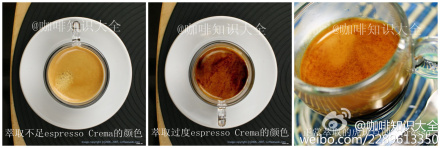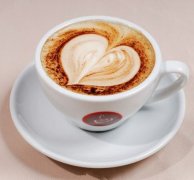Coffee common sense teaches you how to judge a good cup of Espresso

The high-pressure and fast brewing method of coffee is called "Espresso", that is, Espresso originally refers to a method of brewing coffee, and later the coffee brewed in this way is also called Espresso. A perfect cup of Espresso coffee is made by 7-8 grams of roasted coffee beans, ground into a very fine powdered coffee, after proper filling (20Kg), with 9 plus or minus 1 atmospheric pressure and 90 degrees plus or minus 2 degrees hot water, the 30CC coffee concentrate is extracted in 2530 seconds.
People like to drink coffee because it releases flavor and aroma when it is brewed. The sources of flavor in coffee are mostly water-soluble, such as caffeine, protein, sugar and so on, while the sources of aroma are mostly insoluble, such as coffee oil. The volatile aroma of coffee oil is found in roasted coffee cells. Some of these oils are insoluble in water and only emulsify 10% when using an Espresso machine at high temperature and high pressure and float in the hot coffee juice, turning into a rich ochre red Crema. We can judge the quality of a cup of Espresso by the color, thickness, markings and other appearance of Krima.
Espresso coffee tastes particularly thick, and its consistency comes from the fact that when the water flows through the coffee powder to the cup, the carbon dioxide bubbles are suspended in the coffee juice liquid and mixed with an emulsified gel. These gelatinous substances inhibit the taste buds' sense of bitterness, making us feel particularly fragrant and strong when drinking Espresso coffee, but not too bitter. These mixed colloidal substances and emulsified oils become tiny droplets and are responsible for the so-called "rhyme", that is, by reducing the surface tension of the liquid. At the same time, the gel makes the tiny oil droplets penetrate the taste buds deeper, making the oil stay, and then slowly release the aromatic substances attached to it. This aroma can let the olfactory senses know the aroma and throat rhyme for up to 20 minutes after drinking Espresso coffee.
In addition to its unparalleled aroma, consistency and rhyme, Espresso coffee has one of its biggest features: low caffeine. When some people drink Esprsso coffee for the first time, they have the illusion that such strong and pure coffee must have a high caffeine content. In fact, on the contrary, of all the coffee-making methods, coffee is made with the same beans, and the coffee made by the Espresso machine contains the least caffeine. Because the caffeine in coffee is a water-soluble substance, the longer the coffee powder is in contact with water, the more caffeine is dissolved, while the brewing time of Espresso coffee is only more than 20 seconds. When the caffeine is not released, a cup of mellow coffee has already been brewed, so the caffeine content is only 1max, 3mer, 1max, which is generally used in other brewing methods.
Important Notice :
前街咖啡 FrontStreet Coffee has moved to new addredd:
FrontStreet Coffee Address: 315,Donghua East Road,GuangZhou
Tel:020 38364473
- Prev

Turkish Coffee A cup of fortune-telling coffee in the world
Turkish coffee is famous for its peculiar taste, which comes from the peculiar way of preparing coffee. Its taste is recognized as the most original taste of coffee, but also a taste with a long history. This is a real way to make coffee. It grinds the roasted coffee beans into powder and boils them directly with water in a special Turkish pot.
- Next

A cup of good coffee must go through 7 brewing processes
Nanyang coffee is a specialty of Singapore and Malaysia, and Nanyang coffee powder has its own unique production method. Hainan ancestors integrated the roasting technology of Western-style coffee, and under the premise of cost consideration and local taste preference, developed the coffee roasting technology of adding impurities such as white sugar, butter, sesame, corn and so on into coffee beans. Due to the proportion of impurities added and
Related
- Beginners will see the "Coffee pull flower" guide!
- What is the difference between ice blog purified milk and ordinary milk coffee?
- Why is the Philippines the largest producer of crops in Liberia?
- For coffee extraction, should the fine powder be retained?
- How does extracted espresso fill pressed powder? How much strength does it take to press the powder?
- How to make jasmine cold extract coffee? Is the jasmine + latte good?
- Will this little toy really make the coffee taste better? How does Lily Drip affect coffee extraction?
- Will the action of slapping the filter cup also affect coffee extraction?
- What's the difference between powder-to-water ratio and powder-to-liquid ratio?
- What is the Ethiopian local species? What does it have to do with Heirloom native species?

